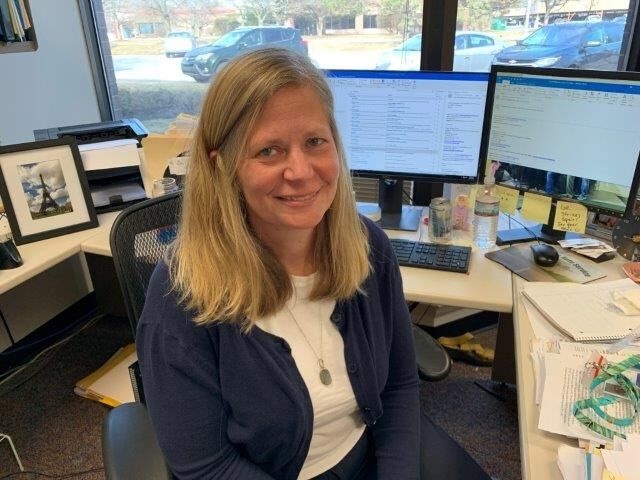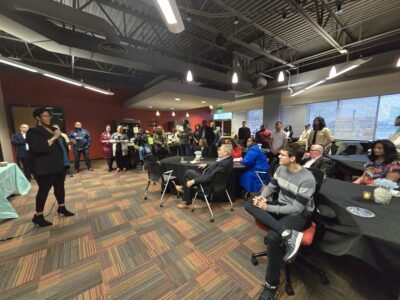The imminent departure of the Creative Vision Factory from its home of 13 years in downtown Wilmington has helped focus attention on the importance of making essential support services easily accessible to individuals with mental health and addiction issues.
But even the Creative Vision Factory, a peer support mental health center that provides a mix of services to assist individuals in need, doesn’t offer what many experts say is most essential: housing.
“Folks in recovery need three things: a home, a sanctuary and a purpose,” said Michael Kalmbach, Creative Vision Factory’s executive director. The drop-in center with an art-focused theme provides both sanctuary and purpose for its clients, but its housing capacity is limited to guiding clients to sources of scarce rental subsidy vouchers.
Of the 485 individuals who have visited Creative Vision Factory in the last six months, 45% have given addresses that indicate that they’re experiencing homelessness. Of that group, 17% said they’re receiving services from a behavioral health provider, 27% said they were not using these services and 10% chose not to disclose this information.
“Housing is the foundation of everything. How do you stabilize your health if you don’t have stable housing?” asked Carrie Casey, general manager of New Castle County’s Department of Community Services and overseer of the Hope Center, the short-term homeless shelter created in a former hotel during the depths of the pandemic.
“Almost everyone [staying at the Hope Center] has a diagnosed or undiagnosed health condition,” Casey said. “At least 75% have either mental health or substance abuse issues, and 100% have had very hard trauma, stress, depression or anxiety.”
Housing, like employment, is a “critical element” on the road to recovery, said Rita Landgraf, secretary of health and social services during the administration of Gov. Jack Markell and until recently director of the University of Delaware’s Partnership for Healthy Communities. “If you’re homeless or housing insecure, you face a disease burden, in both physical health and behavioral health.”
“The challenge lies in changing the narrative,” Landgraf said. Rather than thinking of disadvantaged populations like the mentally ill as a burden, she explains, think of how much more costly it is to society if their needs are not met.
“We have to do this as a system,” she said. “One person at a time can’t do it.”
The ‘permanent supportive housing’ model
Housing and social services experts interviewed for this article consistently pointed to a concept called “permanent supportive housing” (PSH) as the most comprehensive means of addressing the often overlapping challenges of housing instability and mental health and/or substance abuse.
There are other approaches. The “housing first” model prioritizes putting a roof over someone’s head, but its solutions are less comprehensive and have shorter time spans.
The U.S. Department of Housing and Urban Development describes PSH as “permanent housing in which housing assistance, typically long-term leasing or rental assistance, and supportive services are provided to assist households with at least one member (adult or child) with a disability in achieving housing stability.” Those supportive services, tailored to individual needs, can include case management, mental health services, substance abuse treatment, healthcare coordination, life skills training and employment services.
One of the best known examples is Broadway Housing Communities in the upper Manhattan area of New York City. Established in 1983, the organization now has more than 330 housing units — from studio to family-size apartments — in five sites. Its mixed-use buildings house individuals with diverse chronic conditions. Residents can receive a range of social services on site or nearby. About a quarter of the residents earn income by working shifts at the front desk in their building.
There are a limited number of PSH programs in Delaware, including the Life Lines III program created and administered by the West End Neighborhood House in Wilmington to serve youths aging out of the state’s foster care system.
Rachel Stucker, executive director of Housing Alliance Delaware, said the largest PSH operator in Delaware is Conexio Care, which has 58 sites statewide. Some of the sites operated by the Ministry of Caring in Wilmington also meet the PSH definition, she said.

Rachel Stucker, executive director of Housing Alliance Delaware (Courtesy)
Impact Life, the community-based behavioral health support services program that is placing Creative Vision Factory under its umbrella on July 1, has two PSH sites among the 13 residential facilities it now operates statewide and will soon open three more, according to Domenica Personti, its founder and CEO. (Impact Life is in the process of acquiring another property for Creative Vision Factory within Wilmington city limits, but that site will not be available until sometime in August and it will not have a housing component. Meanwhile, CVF clients will be able to receive Impact Life services from the agency’s site in Elsmere, Personti said.)
There are numerous other residences statewide that may look like permanent supportive housing but don’t meet the HUD definition, often because residents don’t have tenancy rights or leases, Stucker said. Typically, she said, these programs focus more on recovery from substance abuse than they do on housing stability.
Impact Life’s non-PSH sites fit into this grouping because a resident’s stay is typically no longer than nine months, Personti said.
The need for PSH in Delaware is dwarfed by a much larger problem: a shortage of more than 22,000 affordable housing units statewide, according to Stephen Metraux, associate professor at the Biden School of Policy and Public Administration at the University of Delaware. Metraux has been researching homelessness and affordable housing for more than 20 years.
Simply building 22,000 units, if that were possible, still wouldn’t work, because some people will still be left out, he said. This could be for any number of reasons: for example, the available unit isn’t close to their job, it’s not near public transportation, or, even with subsidies, they just can’t afford to pay the rent.

Stephen Metraux, associate professor at the Biden School of Policy and Public Administration at the University of Delaware (Courtesy)
And people who are homeless — 1,245 counted in the state in 2023 — make up just a small portion of those in need of affordable housing.
More likely than not, Metraux said, the ones that would be squeezed out would be those with substance abuse or mental health issues. And, he said, if priority were given to those subgroups, another demographic — veterans or the recently incarcerated, for example – would be left outside.
Meeting the needs of these subgroups doesn’t necessarily require new construction, which would be costly and time-consuming, Stucker said. Acquiring and converting vacant or low-occupancy hotels and motels into housing units, as New Castle County did in 2021 with the Hope Center, should be considered, she said.
Factors like health care go into establishing secure housing
Establishing permanent supportive housing is no easy task.
Christian Willauer, a community development consultant who formerly worked in economic development for West End, said there are four essential ingredients to the process: a developer to build or acquire the housing; a property manager to oversee the housing units; a service provider to manage or deliver the social supports that residents need; and a revenue stream to subsidize rents for the residents, since many will be unemployed or underemployed.
Few organizations have the wherewithal to put it all together.
“Developers have the knowledge to construct the housing but don’t have the capacity to operate it. A service provider does not necessarily have the skillset to act as the developer,” said Stephanie Griffin, director of housing development for the Delaware State Housing Authority, which serves as a primary funding channel for many subsidized housing initiatives in the state.
West End’s experience with creating Life Lines’ housing component illustrates the challenges of establishing a functional PSH entity.
“It can be done, but it’s not for the faint of heart,” said Paul Calistro, West End’s longtime executive director. “You need tenacity, passion, real good relationships, and sustainability. You may need a partner, or a couple of partners, to carry it out.”

Paul Calistro, West End’s longtime executive director (Courtesy)
West End created Life Lines more than 20 years ago after Calistro met two teenage girls three weeks before their high school graduation and learned they had nowhere to go after receiving their diplomas because they were aging out of the state’s foster care program.
Over the years, Life Lines grew and evolved, first as a drop-in program and eventually into one that included housing scattered throughout Wilmington and nearby suburbs.
Life Lines now has 13 residences with 33 beds plus a drop-in center that serves as a daytime shelter for young adults ages 18 to 23 who are leaving the state’s foster care program, according to Stacy Shamburger, the program’s director.
Overall, Life Lines serves about 110 individuals, including some who are staying in foster homes, homeless shelters or on their own in subsidized rental housing. The program has expanded its geographic reach, recently purchasing a 10-bedroom former bed and breakfast near the Kent-Sussex county line.
Creating PSH units starts with development. Much of the funding is channeled through the Delaware State Housing Authority, but gifts from foundations, individuals and corporate donors are often essential, Calistro said. It’s not easy to find interested builders either because profit margins are low and the red tape associated with multiple funding sources can be time consuming, he said.
Securing title to a property, whether it’s an old home or a vacant lot, can also be challenging. When organizing Life Lines, West End relied on the Wilmington Neighborhood Conservancy Land Bank to purchase the sites, clear outstanding liens and cover back taxes and fees. Through its work in redeveloping the city’s West Side, West End has good relationships with a number of small builders who have shared in Life Line’s construction work.
For managing the 13 residences and the drop-in center, Shamburger said Life Lines has a property manager and two maintenance workers on the payroll, and brings in contractors for major issues, like plumbing, electrical and HVAC repairs.
To provide support services for residents and drop-ins, Life Lines relies on a combination of employees and volunteers, Shamburger said. Intervention specialists help residents learn the basics of things like grocery shopping and doing their laundry. Case managers guide them through the maze of issues associated with getting a driver’s license, health insurance, food stamps — anything that involves paperwork. A psychologist funded by the state Division of Substance Abuse and Mental Health and a social work fellow from Jewish Family Services Delaware are on site three or four days a week. For medical care, Life Lines directs residents to St. Francis Hospital, just around the corner, or West Side Health Care, just a few blocks away. All Life Lines residents are covered by Medicaid, Shamburger said.
Funding the programming is complex. “We have contracts,” Calistro said, “but everything is ‘to an extent.’” No funder covers the entire tab. HUD grants help cover basic maintenance and furnishings at the housing units; money from the state’s Children’s Department serves as a rent subsidy. On top of that, Calistro said, Life Lines still has to raise $175,000 to $200,000 a year from foundations, businesses and individual donors.
Besides helping these young adults adjust to the realities of day-to-day life after a difficult childhood, Life Lines and other PSH programs have a broader societal benefit.
Providing access to health care and other essential supports prevents larger problems later, said Lillian J. Schonewolf, vice president for community health and well being for Trinity Health Mid-Atlantic, which includes St. Francis Hospital.
Whether it’s young adults in Life Lines, or others with substance abuse or mental health issues, “health care usually isn’t something you’re thinking of at first. By the time you get to the emergency room, if you don’t have access to a family doctor, you probably need high-cost treatment or drugs. If you’re admitted to the hospital, when you’re discharged, you probably go back to the same influences that put you in the hospital,” she said.
Strong support services in PSH not only means better living conditions for residents but also reduces expenses in the long run for healthcare and other service providers, Schonewolf said.
Mixed-use communities are a strong approach
Stucker, the Housing Alliance Delaware head, envisions a PSH arrangement that would be part of mixed- income development, so that some residents would be individuals who need affordable housing but are not experiencing chronic health, substance abuse or employment issues. “People who are living on the streets would be prioritized” in determining eligibility, she said.
“We have to build mixed-use communities,” added Landgraf, the former health and social services secretary. “The challenge lies in changing the narrative, showing that these [disadvantaged] populations aren’t a burden.”
Stucker imagines a complex that would have a support services agency with offices on site or in the neighborhood, with separate staff for social services and housing management. The social services staff would also help residents make connections within the broader community to benefit their lives – links to art or recreation programs, or to a church or civic group. Ideally, she added, all PSH residents would have healthcare costs covered by Medicaid.
Kalmbach, the Creative Vision Factory leader, believes that an ideal PSH entity would need a health-care system as a partner, and probably a university as well.
Cross-community collaboration for a long term solution
In Delaware, finding solutions to issues like this one requires some “Delaware Way”-type action: getting the key players around a table and not letting them out of the conference room until they come up with a solution.
That leads to three questions. Why hasn’t this happened already? Who gets into the conference room? Who sits at the head of the table?
Ray Fitzgerald, a longtime manager in the state Department of Health and Social Services and now executive director, has one answer to the first question. Many leaders in state agencies come up through the ranks in their departments, he said. “They don’t have a global view of the issues and get stuck doing what they have been doing.”
Agencies tend to work within their own silos. “Cross-collaboration is something that definitely needs to happen,” said Griffin, the state housing authority manager.
“Maybe we need a czar for housing, for human health. We have agencies in place but maybe we have to expand their mission,” added Rich Przywara, president and CEO of the Woodlawn Trustees, a developer and manager of working class housing in Wilmington.

Stephanie Griffin, director of housing development for the Delaware State Housing Authority (Courtesy)
Personti, the Impact Life leader, and Casey, overseer of New Castle County’s Hope Center, say they’re seeing agencies — both state and local — talking together more but, as Personti said, “there’s more talk than action.”
A key factor is that no one at the state level has taken ownership. Both Metraux and Landgraf say the Carney administration has not taken an integrated approach to the issues of homelessness and mental health/substance abuse.
“We need leadership that says that these services matter, that it’s important, that there’s a place for these individuals,” Metraux said.
Experts interviewed for this article say the governor, or a top-ranking aide, has to sit at the head of the table of solution-seekers. That’s not likely to happen in the summer of an election year, but Metraux pointed optimistically to the track records of two Democratic candidates for the gubernatorial nomination: New Castle County Executive Matt Meyer led the creation of the Hope Center for the homeless and Lt. Gov. Bethany Hall-Long has done extensive work on substance abuse and mental health issues.
As for who else sits at the table, Fitzgerald and Landgraf say some seats must be allotted to leaders outside government — builders and officials of social services nonprofits, for example.
Others interviewed identified leaders from key divisions of the state’s Housing and Health and Social Services departments and suggested, since there will be costs involved, representation from the state Budget Office and the General Assembly’s Joint Finance Committee.
Fitzgerald thinks the Wilmington Housing Authority should have a seat because his organization can help make connections to HUD and assist smaller organizations in launching housing programs.
Stucker said the group should include experienced for-profit and nonprofit developers of affordable housing as well as planners, both state and local, who have experience with zoning, land use and building codes.
No matter who is in the room, “we have to think out of the box,” Casey said. “It’s about silo-breaking and working together.”
“It’s difficult work,” community development consultant Willauer said. “But we’re a small state, and we could do it. We need to do it.”
Before you go...
Please consider supporting Technical.ly to keep our independent journalism strong. Unlike most business-focused media outlets, we don’t have a paywall. Instead, we count on your personal and organizational support.
Join our growing Slack community
Join 5,000 tech professionals and entrepreneurs in our community Slack today!





